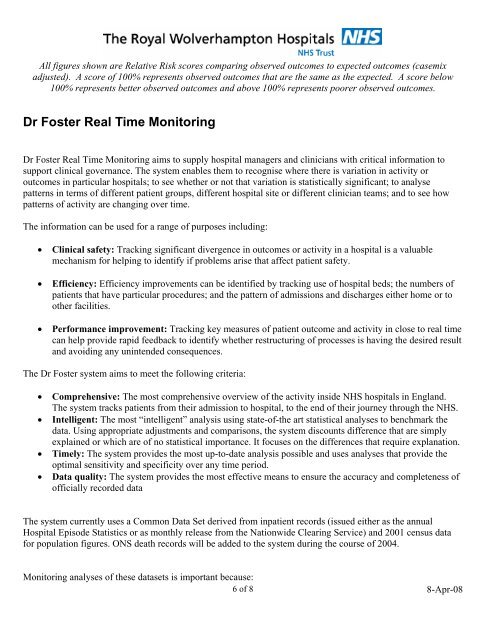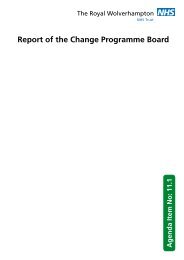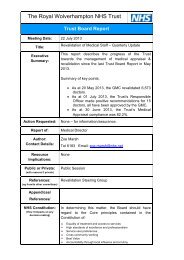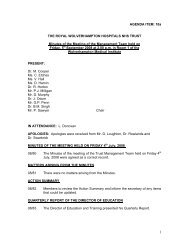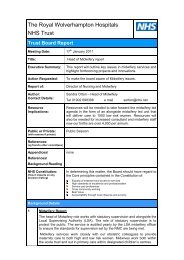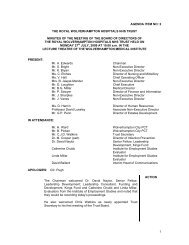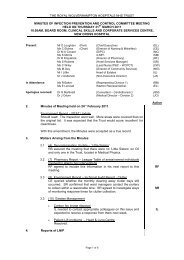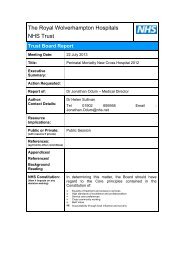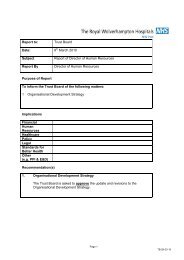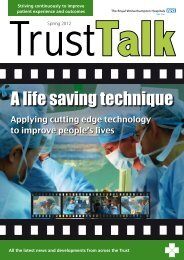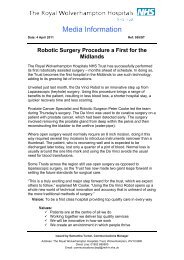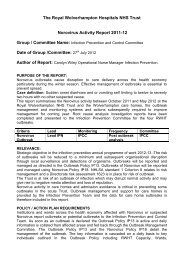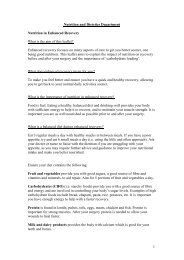Clinical Outcome Report - The Royal Wolverhampton Hospitals NHS ...
Clinical Outcome Report - The Royal Wolverhampton Hospitals NHS ...
Clinical Outcome Report - The Royal Wolverhampton Hospitals NHS ...
You also want an ePaper? Increase the reach of your titles
YUMPU automatically turns print PDFs into web optimized ePapers that Google loves.
All figures shown are Relative Risk scores comparing observed outcomes to expected outcomes (casemixadjusted). A score of 100% represents observed outcomes that are the same as the expected. A score below100% represents better observed outcomes and above 100% represents poorer observed outcomes.Dr Foster Real Time MonitoringDr Foster Real Time Monitoring aims to supply hospital managers and clinicians with critical information tosupport clinical governance. <strong>The</strong> system enables them to recognise where there is variation in activity oroutcomes in particular hospitals; to see whether or not that variation is statistically significant; to analysepatterns in terms of different patient groups, different hospital site or different clinician teams; and to see howpatterns of activity are changing over time.<strong>The</strong> information can be used for a range of purposes including:• <strong>Clinical</strong> safety: Tracking significant divergence in outcomes or activity in a hospital is a valuablemechanism for helping to identify if problems arise that affect patient safety.• Efficiency: Efficiency improvements can be identified by tracking use of hospital beds; the numbers ofpatients that have particular procedures; and the pattern of admissions and discharges either home or toother facilities.• Performance improvement: Tracking key measures of patient outcome and activity in close to real timecan help provide rapid feedback to identify whether restructuring of processes is having the desired resultand avoiding any unintended consequences.<strong>The</strong> Dr Foster system aims to meet the following criteria:• Comprehensive: <strong>The</strong> most comprehensive overview of the activity inside <strong>NHS</strong> hospitals in England.<strong>The</strong> system tracks patients from their admission to hospital, to the end of their journey through the <strong>NHS</strong>.• Intelligent: <strong>The</strong> most “intelligent” analysis using state-of-the art statistical analyses to benchmark thedata. Using appropriate adjustments and comparisons, the system discounts difference that are simplyexplained or which are of no statistical importance. It focuses on the differences that require explanation.• Timely: <strong>The</strong> system provides the most up-to-date analysis possible and uses analyses that provide theoptimal sensitivity and specificity over any time period.• Data quality: <strong>The</strong> system provides the most effective means to ensure the accuracy and completeness ofofficially recorded data<strong>The</strong> system currently uses a Common Data Set derived from inpatient records (issued either as the annualHospital Episode Statistics or as monthly release from the Nationwide Clearing Service) and 2001 census datafor population figures. ONS death records will be added to the system during the course of 2004.Monitoring analyses of these datasets is important because:6 of 8 8-Apr-08


